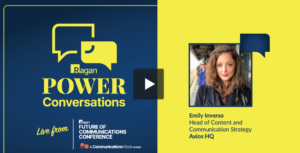Get Out The Vote strategies to engage employees ahead of the 2024 election
Moving from employee engagement to activation.

Alex Wirth is the co-founder and CEO of Quorum.
As the 2024 election draws near, communicators play a crucial role in empowering their employees as voters. Employees often trust their employers to provide more reliable information than the government, making organizations an effective voice to encourage civic engagement, especially through “Get Out the Vote” (GOTV) initiatives.
Here are three compelling reasons why communicators should help their organizations prioritize GOTV efforts:
- Building on trust
Americans hold their employers in higher regard than many other institutions. This year’s Edelman Trust Barometer, which has measured global trust for more than 20 years, found that 79% of respondents trust their employers. In the U.S. specifically, 40% trust government institutions compared to 53% who trust businesses.
This trust becomes particularly significant in the context of the upcoming election. Voters crave reliable information from a respected source, and businesses can provide non-partisan resources and encourage civic participation.
- Enhancing corporate citizenship
Ignoring upcoming elections isn’t an option. From national leadership to local races, the consequences of voting — or not voting — will impact you and your employees. Nonpartisan efforts supporting civic engagement complement your existing initiatives in charitable work, community involvement, sustainability, environmental responsibility, and diversity and inclusion.
Glassdoor found that 61% of U.S. workers discussed politics at work in the past year. And more than ever, employees expect leaders to be vocal about social issues: 62% of those Edelman surveyed expect CEOs to respond to social changes.
With so much on the line in this year’s elections — from the presidency to the entire U.S. House and 33 Senate seats, 11 governors and over 5,000 state lawmakers in 44 states facing voters — sharing reliable, unbiased information with as many people as possible is crucial.
- Keeping up with demand
Disregarding employee engagement in voting suggests more than just an old-fashioned attitude. It puts companies at a competitive disadvantage.
Civic Alliance, a nonpartisan coalition of businesses, found that civic engagement fosters purpose and contributes meaningfully to employee engagement. In addition to strong market returns, businesses implementing civic engagement strategies saw greater consumer loyalty and improved well-being among their workforce and community.
The results are undeniable: Corporate involvement in GOTV efforts is rapidly becoming the norm.
Developing your GOTV program
Every impactful GOTV program starts with acknowledging the election’s impact on your stakeholders and your organization’s role in supporting informed participation. Consider these best practices:
- Start preparing early in the election cycle.
- Use existing communication channels like Slack or Teams, newsletters and team meetings to spread awareness.
- Lean on nonpartisan civic organizations for resources.
- Align messaging with the brand values you already champion.
- Take advantage of civic holidays like primaries, conventions and National Voter Registration Day to engage people.
- Emphasize that your program aims to encourage voting overall, not to support any particular candidate or point of view.
Nailing the basics
Based on the time and resources you can devote to your GOTV campaign, you might focus on a few essential elements before expanding. If so, start with three simple steps:
- Encourage team members to vote with a note from a company executive. Tie your GOTV program to a company value by having a company executive send a message of encouragement. Aligning your voting campaign with a core company value motivates employees to vote and enhances the company’s reputation as socially responsible. Remember, this initiative isn’t about making money but about promoting civic engagement.
This simple action can significantly boost employee participation in the campaign.
- Provide a way to uncover the key information needed to participate. A GOTV landing page bridges the gap from encouragement to education. A nonpartisan hub where employees can seek answers and become better-informed voters cements your organization’s role as a trustworthy institution.
Your intranet, or other internal platforms can give employees a dedicated place to check:
- Online voter registration and status.
- Candidates and ballot measures.
- Voting rules and instructions.
- Polling place and satellite locations.
- Important dates and deadlines.
- Information on early voting, absentee ballots or voting by mail.
By offering these valuable services from a trusted source, you ease the path to participate in the election process.
In 2020, Expedia created a branded GOTV election center. The result? Expedia employees visited the center more than 8,000 times, with hundreds looking up candidates and registering to vote. Plus, nearly 150 employees cast votes for the first time.
You can maximize employee participation through regular, targeted emails. Establishing a baseline of recurring communication around key dates ensures consistent delivery of important information and encourages employee participation. Employees will trust you to support their civic engagement when you offer reminders timed with key dates for registration, primaries and the general election, emphasizing deadlines and milestones. Don’t forget targeted messages with early voting, absentee ballot and voting by mail details so employees understand their options.
Take it up a level
If you’re dedicated to maximizing voter turnout, advance your education tactics and expand into activation. Consider adding:
- Time off to vote. A recent Pew Research study found that 72% of Americans support making Election Day a national holiday. Some companies provide paid time off to vote, while others declare a meeting-free day so employees can cast their ballots.
Initiatives like Time to Vote, with members like Aflac, Dell and Instacart, include over 2,000 participating companies. Similarly, Electionday.org has over 1,000 companies signed up, including Lyft, Paramount and T-Mobile — all dedicated to making voting easier for their employees. - Non-partisan education. Offer expert-led “lunch & learns” on key election issues, presented in a balanced, factual manner.
- Candidate interactions. If appropriate and practical, host virtual or in-person visits from both parties for direct, neutral candidate engagement.
- Gamification incentives. Motivate participation with points, badges and small rewards for actions, making the voting process fun and interactive.
These tactics empower organizations to move beyond simply providing information to spark engagement and drive impactful voter participation.
Regardless of your program’s scope, the goal is the same: increasing engagement. Your audience will discuss the election all year. Be part of that conversation in a helpful, supportive way.






